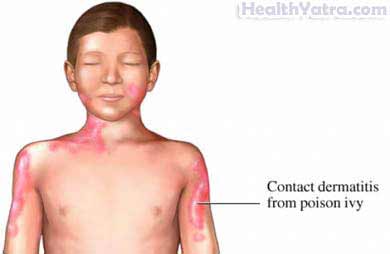সংজ্ঞা
Poison ivy, poison oak, and poison sumac are plants that cause a rash in those allergic to them. This rash is caused by a chemical in the sap. About 50%-70% of people are sensitized to this chemical and are, therefore, allergic. Virtually everyone will eventually become sensitized if repeatedly exposed.

কারণসমূহ
The allergic reactions to poison ivy, oak, and sumac occur when sensitized people come in contact with urushiol oil. This oil is found in the roots, stems, leaves, and fruit of the plant. This oil is released if the plant is damaged or bruised.
If not washed, oil from these plants may stay potent for years on clothing, tools, toys, and other items, especially in dry conditions.
ঝুঁকির কারণ
A risk factor is something that increases your chance of getting a disease or condition. Sensitized people are at risk if they:
- Work or play in wooded areas during the spring, summer, and fall
- Touch pets or animals that have come in contact with these plants
- Handle clothes or objects that have come in contact with these plants
- Are exposed to the smoke of these plants if they are burned
লক্ষণ
The main symptom of poison oak, ivy, or sumac is an intensely itchy, red rash. The rash appears within 24-72 hours of exposure to the oil. The rash often appears streaked and may develop into oozing blisters. The oozing material will not sensitize others.
The skin rash may cause discomfort. It is not serious, though, and usually resolves on its own in 1-2 weeks. However, you should contact a doctor right away if you are highly sensitive or have the following symptoms:
- Swelling of the face or throat
- Rash on the genitals
- Swelling or rash that covers more than one third of your body
- Rapidly spreading rash
- Signs of a bacterial infection, such as pain, increased redness, or pus
রোগ নির্ণয়
Diagnosis of poison ivy, oak, or sumac is based on the presence of a characteristic itchy rash and possible exposure to plants containing urushiol oil.
চিকিৎসা
If Exposed:
If you have been exposed to poison ivy, oak, or sumac, wash your entire body immediately. You can reduce your chance of getting a rash if you wash thoroughly with soap and water within 10-15 minutes of exposure. Using alcohol and water wash all clothes, tools, and shoes that were in contact with the plant. One small study shows that cleaning with the oil-removing compound “Goop” or the poison-ivy prevention substance “Tecnu” is more effective than using soap alone. All three treatments reduced the occurrence of skin rash by more than 50% following contact.
If Rash Develops:
If a rash develops, the itching and blisters will usually disappear in 7-14 days without treatment. Treatment to reduce discomfort includes:
- Cool compresses with water or whole milk
- ওরাল এন্টিহিস্টামাইনস
- Over-the-counter medications:
- Calamine lotion
- Zinc oxide or baking soda (to dry oozing blisters)
- Diluted aluminum acetate solution (Burow’s solution)
- Steroid medications:
- Cortisone creams—can relieve symptoms and may also shorten the duration of the rash
- These are available over-the-counter (much weaker) and by prescription.
- Oral corticosteroids—may be prescribed in severe cases
- Cortisone creams—can relieve symptoms and may also shorten the duration of the rash
If you are diagnosed with a rash from poison ivy, oak, or sumac, follow your doctor’s instructions.
প্রতিরোধ
To prevent a rash from poison ivy, oak, or sumac:
- Learn what the plants look like and avoid all contact with them.
- Never burn these plants.
- Wear clothes that cover as much skin as possible when in wooded areas.
- Bathe pets in soapy water if you think they have come in contact with one of these plants.
- Wash any clothing or object that may have come in contact with these plants.
- Use an over-the-counter medication (such as Ivy Block, Stokoguard [bentoquatam 5%]). This may help prevent a rash if applied at least 15 minutes before exposure.
